3320 North Buffalo Drive
Suite 107
Las Vegas, NV 89129
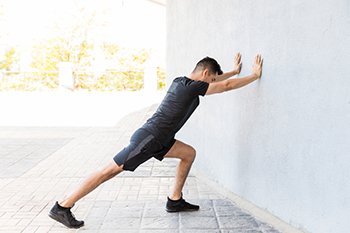
When athletes, and especially runners, stretch tight calf muscles, they may be doing more harm than good to the Achilles tendon, experts say. Short active stretches may be more beneficial than passive stretching, where the heel is pressed downward and held for an extended period of time. Research has shown an overload on the Achilles tendon can cause it to become inflamed. When a typical calf/Achilles tendon stretch is performed, it’s normal for the tendon to press against the heel bone. However, when this position is gained too forcefully or sustained for too long it can become a problem. In fact, it is believed that overdoing a heel drop stretch of the Achilles tendon and calf can actually contribute to Achilles tendonitis. For this reason, experts recommend a heel drop flat against the floor rather than from a stair step, where the heel goes below the horizontal plane. Instead, massage, foam rolling, and double heel raises can help do the job of relieving tightness. For more detailed guidance on how to avoid Achilles tendonitis, please consult a podiatrist.
Achilles tendon injuries need immediate attention to avoid future complications. If you have any concerns, contact one of our podiatrists of Summerlin Foot & Ankle. Our doctors can provide the care you need to keep you pain-free and on your feet.
What Is the Achilles Tendon?
The Achilles tendon is a tendon that connects the lower leg muscles and calf to the heel of the foot. It is the strongest tendon in the human body and is essential for making movement possible. Because this tendon is such an integral part of the body, any injuries to it can create immense difficulties and should immediately be presented to a doctor.
What Are the Symptoms of an Achilles Tendon Injury?
There are various types of injuries that can affect the Achilles tendon. The two most common injuries are Achilles tendinitis and ruptures of the tendon.
Achilles Tendinitis Symptoms
Rupture Symptoms
Treatment and Prevention
Achilles tendon injuries are diagnosed by a thorough physical evaluation, which can include an MRI. Treatment involves rest, physical therapy, and in some cases, surgery. However, various preventative measures can be taken to avoid these injuries, such as:
If you have any questions please feel free to contact our office located in Las Vegas, NV . We offer the newest diagnostic tools and technology to treat your foot and ankle needs.
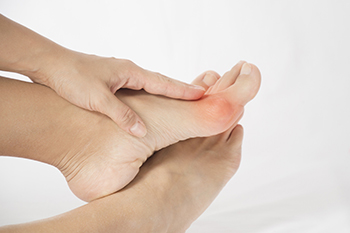
There are a variety of afflictions of the feet that can negatively impact the area around the toes. Bunions are one such foot condition. A bunion is a bony bump that can develop on the side of the foot, particularly on the side of the big toe or on the side of the pinky toe. Many individuals are curious to know what a bunion looks like for good reasons because being aware of this can help you identify a bunion at an early stage. Commonly, a bunion looks like a bulge. When the bunion is located on the side of the big toe, it might look as though the foot bone juts out at an angle. In some cases of bunions, the toes might even look crowded because of the bunion. The big toe might also look like it is turned inward. Contact a podiatrist today for more information about what bunions look like.
If you are suffering from bunions, contact one of our podiatrists of Summerlin Foot & Ankle. Our doctors can provide the care you need to keep you pain-free and on your feet.
What Is a Bunion?
A bunion is formed of swollen tissue or an enlargement of boney growth, usually located at the base joint of the toe that connects to the foot. The swelling occurs due to the bones in the big toe shifting inward, which impacts the other toes of the foot. This causes the area around the base of the big toe to become inflamed and painful.
Why Do Bunions Form?
Genetics – Susceptibility to bunions are often hereditary
Stress on the feet – Poorly fitted and uncomfortable footwear that places stress on feet, such as heels, can worsen existing bunions
How Are Bunions Diagnosed?
Doctors often perform two tests – blood tests and x-rays – when trying to diagnose bunions, especially in the early stages of development. Blood tests help determine if the foot pain is being caused by something else, such as arthritis, while x-rays provide a clear picture of your bone structure to your doctor.
How Are Bunions Treated?
If you have any questions, please feel free to contact our office located in Las Vegas, NV . We offer the newest diagnostic and treatment technologies for all your foot care needs.
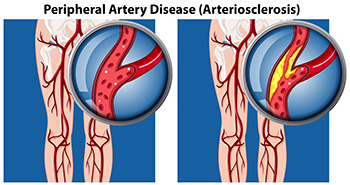
Damage that happens to the peripheral nervous system may be referred to as peripheral neuropathy. This can lead to peripheral artery disease, and the abbreviation for this is PAD. There are various groups of nerves that can be affected by this condition. These are the motor nerves and are used for walking and talking. When information is transmitted from the brain to the body that consists of temperature or slight pain, it falls into the sensory nerve category. Activities that happen naturally such as breathing, and digesting foods are part of the autonomic nerves. Damage can occur to these nerve groups as a result of diabetes, vascular problems, or autoimmune diseases. Additionally, kidney and liver disorders may contribute to developing PAD. Common symptoms can include the inability to feel sensations in the feet, and walking may become difficult. If you have diabetes and have a loss of feeling in your feet, it is strongly urged that you are under the care of a podiatrist who can effectively treat PAD.
Peripheral artery disease can pose a serious risk to your health. It can increase the risk of stroke and heart attack. If you have symptoms of peripheral artery disease, consult with one of our podiatrists from Summerlin Foot & Ankle. Our doctors will assess your condition and provide you with quality foot and ankle treatment.
Peripheral artery disease (PAD) is when arteries are constricted due to plaque (fatty deposits) build-up. This results in less blood flow to the legs and other extremities. The main cause of PAD is atherosclerosis, in which plaque builds up in the arteries.
Symptoms
Symptoms of PAD include:
It is important to note that a majority of individuals never show any symptoms of PAD.
Diagnosis
While PAD occurs in the legs and arteries, Podiatrists can diagnose PAD. Podiatrists utilize a test called an ankle-brachial index (ABI). An ABI test compares blood pressure in your arm to you ankle to see if any abnormality occurs. Ultrasound and imaging devices may also be used.
Treatment
Fortunately, lifestyle changes such as maintaining a healthy diet, exercising, managing cholesterol and blood sugar levels, and quitting smoking, can all treat PAD. Medications that prevent clots from occurring can be prescribed. Finally, in some cases, surgery may be recommended.
If you have any questions, please feel free to contact our office located in Las Vegas, NV . We offer the newest diagnostic and treatment technologies for all your foot care needs.
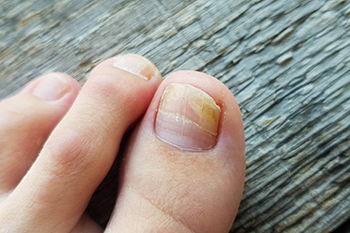
Anyone is at risk for developing toenail fungus. It is a common infection that attacks the nail bed on the toes. Research has shown that the chances of incurring this may increase as the aging process occurs. Additionally, there may be existing medical conditions that can lead to getting this type of infection. These include poor circulation, psoriasis, or a weakened immune system. The fungus that causes this lives and thrives in warm and moist environments, including public swimming pools, locker rooms, and shower room floors. Because it can enter the body through small cuts in the feet, it is suggested to wear appropriate shoes while in these types of areas. Toenail fungus is contagious, and it is wise to refrain from sharing shoes, socks, and towels which may help to stop its spread. The symptoms are generally noticeable, as the toenails become yellow and brittle. Additionally, the skin may itch. Medical attention is often sought that can help to restore the nails to normalcy. As soon as you see the symptoms of a toenail fungus infection, it is strongly advised that you see a podiatrist who can guide you toward the correct treatment options.
If left untreated, toenail fungus may spread to other toenails, skin, or even fingernails. If you suspect you have toenail fungus it is important to seek treatment right away. For more information about treatment, contact one of our podiatrists of Summerlin Foot & Ankle. Our doctors can provide the care you need to keep you pain-free and on your feet.
Symptoms
Treatment
If self-care strategies and over-the-counter medications does not help your fungus, your podiatrist may give you a prescription drug instead. Even if you find relief from your toenail fungus symptoms, you may experience a repeat infection in the future.
Prevention
In order to prevent getting toenail fungus in the future, you should always make sure to wash your feet with soap and water. After washing, it is important to dry your feet thoroughly especially in between the toes. When trimming your toenails, be sure to trim straight across instead of in a rounded shape. It is crucial not to cover up discolored nails with nail polish because that will prevent your nail from being able to “breathe”.
In some cases, surgical procedure may be needed to remove the toenail fungus. Consult with your podiatrist about the best treatment options for your case of toenail fungus.
If you have any questions, please feel free to contact our office located in Las Vegas, NV . We offer the newest diagnostic and treatment technologies for all your foot care needs.
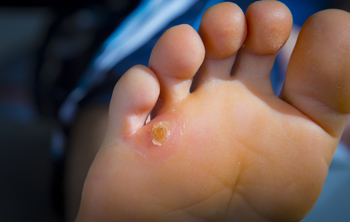
People who experience corns are aware of how painful they can be. A corn can develop in several places on the feet, including the pinky toe, the sole of the foot, or between the toes. It is a hardened area of skin that happens in response to pressure that is exerted in a particular place on the foot. They gradually form as a result of excessive friction that generally comes from wearing shoes and socks that do not fit correctly. Corns are divided into three categories, and this is based on where they develop. A soft corn is found between the toes and is named because of the constant moisture that is found in this area. Smaller corns are known as seed corns and are found on the bottom of the foot. They can be painful from the pressure that is exerted on this part of the foot. The top of the toes may produce hard corns and can be equally as painful. If you have a corn on your foot, it is suggested that you speak to a podiatrist who can bring you relief with appropriate treatments.
If you have any concerns regarding your feet and ankles, contact one of our podiatrists of Summerlin Foot & Ankle. Our doctors will treat your foot and ankle needs.
Corns: What Are They? and How Do You Get Rid of Them?
Corns can be described as areas of the skin that have thickened to the point of becoming painful or irritating. They are often layers and layers of the skin that have become dry and rough, and are normally smaller than calluses.
Ways to Prevent Corns
There are many ways to get rid of painful corns such as wearing:
Treating Corns
Treatment of corns involves removing the dead skin that has built up in the specific area of the foot. Consult with Our doctors to determine the best treatment option for your case of corns.
If you have any questions please feel free to contact our office located in Las Vegas, NV . We offer the newest diagnostic and treatment technologies for all your foot and ankle needs.